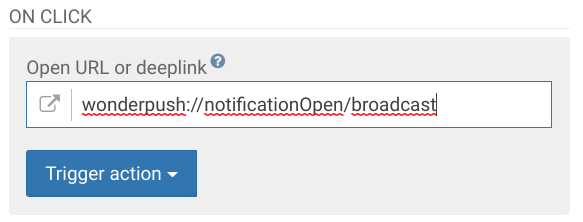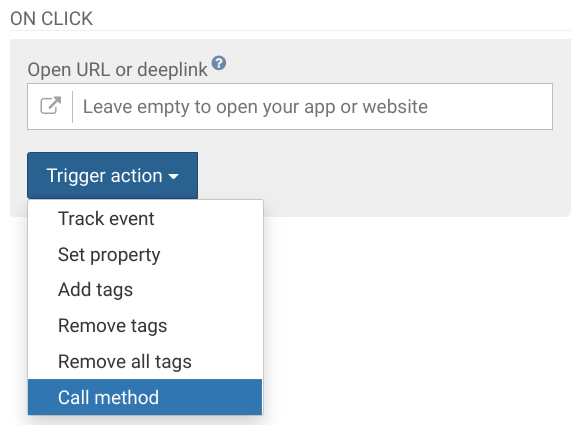Deprecated ways of handling notification clicks
If you are looking for our legacy ways of handling notification clicks, we've saved the documentation for you.
Handling click broadcasts (deprecated)
When a notification is clicked whose action is to open the special URL wonderpush://notificationOpen/broadcast, our SDKs forward this click to your app or website without taking any other action.
Such notifications can be created from the online dashboard by entering wonderpush://notificationOpen/broadcast as the On-click URL in the composition form.

You can listen to these clicks and decide what to do by adding a small amount of code.
Handling click broadcasts on a Website requires updating a Service WorkerIf you are not familiar with Service Workers, you'll find Getting started articles on MDN or Google.
Handling click broadcasts on a Website is only possible if you are using your own push notification domain. If you are using a *.by.wonderpush.com domain, it is not currently possible to consume data from push notification payloads.
// Only websites using their own push notification domain can handle click broadcasts
// This code goes in the wonderpush-worker-loader.min.js service worker file you've installed at the root of your website when setting up WonderPush
self.addEventListener('WonderPushEvent', function(event) {
// Click broadcasts are events with .detail.type === 'notificationOpened'
if (event && event.detail && event.detail.type === 'notificationOpened') {
// The event object contains the original 'notificationclick' event object
// in its .detail.event property.
// The notification clicked is available like so:
console.log('Notification clicked:', event.detail.event.notification);
}
});// Listen to a NotificationCenter notification.
// A good place to put this code is your AppDelegate's application:didFinishLaunchingWithOptions:
NotificationCenter.default.addObserver(forName: NSNotification.Name(rawValue: WP_NOTIFICATION_OPENED_BROADCAST), object: nil, queue: nil, using: {notification in
if let pushNotification = notification.userInfo {
debugPrint("Notification clicked:", pushNotification)
}
})// Listen to a NSNotificationCenter notification.
// A good place to put this code is your AppDelegate's application:didFinishLaunchingWithOptions:
[[NSNotificationCenter defaultCenter] addObserverForName:WP_NOTIFICATION_OPENED_BROADCAST object:nil queue:nil usingBlock:^(NSNotification *note) {
NSDictionary *pushNotification = note.userInfo;
NSLog(@"Notification clicked: %@", pushNotification);
}];LocalBroadcastManager.getInstance(this).registerReceiver(new BroadcastReceiver() {
@Override
public void onReceive(Context context, Intent intent) {
if (!WonderPush.INTENT_NOTIFICATION_WILL_OPEN_EXTRA_NOTIFICATION_TYPE_DATA.equals(
intent.getStringExtra(WonderPush.INTENT_NOTIFICATION_WILL_OPEN_EXTRA_NOTIFICATION_TYPE))) {
Intent pushNotif = intent.getParcelableExtra(WonderPush.INTENT_NOTIFICATION_WILL_OPEN_EXTRA_RECEIVED_PUSH_NOTIFICATION);
Log.d("WonderPush", pushNotif.toString());
// You should now start your application on the appropriate screen.
}
}
}, new IntentFilter(WonderPush.INTENT_NOTIFICATION_WILL_OPEN));document.addEventListener('wonderpush.notificationOpen', function onNotificationOpen(event) {
// This is called for data notifications when they are received and for regular notifications when they are clicked
if (event.notificationType != "data") {
console.log("Clicked notification:", event.notification);
// On Android, you should now start your application on the appropriate screen.
}
}, false);WonderPush.eventEmitterWonderPush.addListener('wonderpushNotificationWillOpen', (event) => {
console.log('Notification clicked:', event);
// On Android, you should now start your application on the appropriate screen.
});This feature is not supported yet on Flutter.
We'd like to hear about your use case.Registering a callback (deprecated)
Registering a callback allows you to execute some code when a push notification is clicked.
Please note that deep links are a good way of achieving the same thing on mobile applications.
Users of the online dashboard can plug your code directly inside their notification buttons by choosing the option to trigger a Call method from the composition form of the notification edition interface:


This technique is not available in our Website SDK
To register a callback, you'll need a few lines of code. In the following example, we register a callback named example:
// Put the following call in the [application:didFinishLaunchingWithOptions:] method of your AppDelegate
// Here is how to register the callback named "example"
NotificationCenter.default.addObserver(forName: NSNotification.Name(rawValue: "example"), object: nil, queue: nil, using: {notification in
let arg = notification.userInfo?[WP_REGISTERED_CALLBACK_PARAMETER_KEY] as? String
// Do something useful here
})// Put the following call in the [application:didFinishLaunchingWithOptions:] method of your AppDelegate
// Here is how to register the callback named "example"
[[NSNotificationCenter defaultCenter] addObserverForName:@"example" object:nil queue:nil usingBlock:^(NSNotification *note) {
NSString *arg = [note.userInfo objectForKey:WP_REGISTERED_CALLBACK_PARAMETER_KEY];
// Do something useful here
}];// Put the following call before you initialize the SDK, in your Application class
// Here is how to register the callback named "example"
IntentFilter exampleMethodIntentFilter = new IntentFilter();
exampleMethodIntentFilter.addAction(WonderPush.INTENT_NOTIFICATION_BUTTON_ACTION_METHOD_ACTION);
exampleMethodIntentFilter.addDataScheme(WonderPush.INTENT_NOTIFICATION_BUTTON_ACTION_METHOD_SCHEME);
exampleMethodIntentFilter.addDataAuthority(WonderPush.INTENT_NOTIFICATION_BUTTON_ACTION_METHOD_AUTHORITY, null);
exampleMethodIntentFilter.addDataPath("/example", PatternMatcher.PATTERN_LITERAL); // Note: prepend a / to the actual method name
LocalBroadcastManager.getInstance(this).registerReceiver(new BroadcastReceiver() {
@Override
public void onReceive(Context context, Intent intent) {
String arg = intent.getStringExtra(WonderPush.INTENT_NOTIFICATION_BUTTON_ACTION_METHOD_EXTRA_ARG);
// Do something useful here
}
}, exampleMethodIntentFilter);document.addEventListener('wonderpush.registeredCallback', function(event) {
console.log("Callback called for method", event.method, "with arg", event.arg);
}, false);This feature is not supported yet on React Native.
We'd like to hear about your use case.
In the meantime, you can probably achieve what you're trying to do with a deep linkThis feature is not supported yet on Flutter.
We'd like to hear about your use case.
In the meantime, you can probably achieve what you're trying to do with a deep linkUpdated 6 months ago
